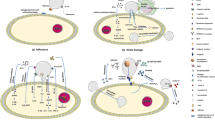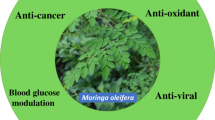Abstract
Mycoplasma pneumoniae pneumonia (MPP) is the most common respiratory infection in young children and its incidence has increased worldwide. In this study, high expression of chemokine ligand 5 (CCL5) was observed in the serum of MPP patients, and its expression was positively correlated to DNA of M. pneumoniae (MP-DNA). In vitro, M. pneumoniae (MP) infection to A549 cells induced the expression of CCL5, chemokines receptor 4 (CCR4), nuclear factor-κB (NF-κB) nuclear protein, and phosphorylation of NF-κB-p65 (p-NF-κB-p65), whereas NF-κB cytoplasmic protein was decreased. On the contrary, treatment of hyperoside counteracted the induction of MP infection and promoted the proliferation of MP-infected A549 cells. Similarly, MP-induced IL-8 and TNF-α production was also markedly reduced by hyperoside. And CCR4 inhibitor AZD2098 had a better effect than hyperoside. In addition, CCL5 recombinant protein inhibited the effect of hyperoside to promote IL-8 and TNF-α production and CCR4 expression. These results indicated that CCL5 may be involved in the progression of MPP, and hyperoside was beneficial for MPP probably through CCL5–CCR4 interactions, which may provide a potential effective therapy for MPP.





Similar content being viewed by others
References
Foy HM (1993) Infections caused by Mycoplasma pneumoniae and possible carrier state in different populations of patients. Clin Infect Dis 17(Suppl 1(Supplement 1):S37
Noah ND (1974) Mycoplasma pneumoniae Infection in the United Kingdom—1967-73. Br Med J 2(5918):544
Foy HM, Kenny GE, Mcmahan R, Mansy AM, Grayston JT (1970) Mycoplasma pneumoniae pneumonia in an urban area. Five years of surveillance. JAMA 214(9):1666–1672
Eaton MD, William VH, Gordon M (1945) Studies on the etiology of primary atypical pneumonia. J Exp Med 82(5):649–668
Defilippi A, Silvestri M, Tacchella A et al (2008) Epidemiology and clinical features of Mycoplasma pneumoniae infection in children. Respir Med 102(12):1762–1768
Michelow IC, Olsen K, Lozano J et al (2004) Epidemiology and clinical characteristics of community-acquired pneumonia in hospitalized children. Pediatrics 113(4):701
Waites KB, Talkington DF (2004) Mycoplasma pneumoniae and its role as a human pathogen. Clin Microbiol Rev 17(4):697–728
Lenglet A, Herrador Z, Magiorakos AP, Leitmeyer K, Coulombier D (2012) Surveillance status and recent data for Mycoplasma pneumoniae infections in the European Union and European Economic Area, January 2012. Euro surveillance 17(5):2–7
Diaz MH, Benitez AJ, Winchell JM (2015) Investigations of Mycoplasma pneumoniae infections in the United States: trends in molecular typing and macrolide resistance from 2006 to 2013. J Clin Microbiol 53(1):124–130
Kim EK, Youn YS, Rhim JW, Shin MS, Kang JH, Lee KY (2015) Epidemiological comparison of three Mycoplasma pneumoniae pneumonia epidemics in a single hospital over 10 years. Korean J Pediatr 58(5):172–177
Alam R (1997) Chemokines in allergic inflammation. J Allergy Clin Immunol 99(3):273–277
Mccormack G, Moriarty D, O’Donoghue DP, Mccormick PA, Sheahan K, Baird AW (2001) Tissue cytokine and chemokine expression in inflammatory bowel disease. Inflamm Res 50(10):491–495
Ben-Baruch A (2006) Inflammation-associated immune suppression in cancer: the roles played by cytokines, chemokines and additional mediators. Semin Cancer Biol 16(1):38–52
Tran MT, Tellaetxe-Isusi M, Elner V, Strieter RM, Lausch RN, Oakes JE (1996) Proinflammatory cytokines induce RANTES and MCP-1 synthesis in human corneal keratocytes but not in corneal epithelial cells. Beta-chemokine synthesis in corneal cells. Investig Ophthalmol Vis Sci 37(6):987
Bouchelouche K, Alvarez S, Horn T, Nordling J, Bouchelouche P (2006) Human detrusor smooth muscle cells release interleukin-6, interleukin-8, and RANTES in response to proinflammatory cytokines interleukin-1beta and tumor necrosis factor-alpha. Urology 67(1):214–219
Tak PP, Firestein GS (2001) NF-kappaB: a key role in inflammatory diseases. J Clin Investig 107(1):7–11
Hang CH, Shi JX, Li JS, Wu W, Yin HX (2005) Concomitant upregulation of nuclear factor-kB activity, proinflammatory cytokines and ICAM-1 in the injured brain after cortical contusion trauma in a rat model. Neurol India 53(3):312–317
Yang J, Hooper WC, Phillips DJ, Talkington DF (2002) Regulation of proinflammatory cytokines in human lung epithelial cells infected with Mycoplasma pneumoniae. Infect Immun 70(7):3649
Middleton E Jr, Kandaswami C, Theoharides TC (2000) The effects of plant flavonoids on mammalian cells: implications for inflammation, heart disease, and cancer. Pharmacol Rev 52(4):673–751
Donatof. Romagnolo M, Selmin O (2012) Flavonoids and cancer prevention: a review of the evidence. J Nutr Gerontol Geriatr 31(3):206–238
Zou Y, Yanhua Lu A, Wei D (2004) Antioxidant activity of a flavonoid-rich extract of Hypericum perforatum L. in vitro. J Agric Food Chem 52(16):5032–5039
Kim SJ, Um JY, Lee JY (2011) Anti-inflammatory activity of hyperoside through the suppression of nuclear factor-κB activation in mouse peritoneal macrophages. Am J Chin Med 39(01):171–181
Ku SK, Zhou W, Lee W, Han MS, Na M, Bae JS (2015) Anti-inflammatory effects of hyperoside in human endothelial cells and in mice. Inflammation 38(2):784–799
Ku SK, Kwak S, Kwon OJ, Bae JS (2014) Hyperoside inhibits high-glucose-induced vascular inflammation in vitro and in vivo. Inflammation 37(5):1389–1400
Hong JY, Kang B, Ahyoun K et al (2011) Development of a highly sensitive real-time one step RT-PCR combined complementary locked primer technology and conjugated minor groove binder probe. Virol J 8(1):330
Starczynowski DT, Lockwood WW, Deléhouzée S et al (2011) TRAF6 is an amplified oncogene bridging the RAS and NF-κB pathways in human lung cancer. J Clin Investig 121(10):4095–4105
Ke SZ, Ni XY, Zhang YH, Wang YN, Wu B, Gao FG (2013) Camptothecin and cisplatin upregulate ABCG2 and MRP2 expression by activating the ATM/NF-κB pathway in lung cancer cells. Int J Oncol 42(4):1289–1296
Yin M, Ren X, Zhang X et al (2014) Selective killing of lung cancer cells by miRNA-506 molecule through inhibiting NF-κB p65 to evoke reactive oxygen species generation and p53 activation. Oncogene 34(6):691–703
Ping L, Uuml (2016) Inhibitory effects of hyperoside on lung cancer by inducing apoptosis and suppressing inflammatory response via caspase-3 and NF-κB signaling pathway. Biomed Pharmacother 82:216–225
Erfani N, Nedaei Ahmadi AS, Ghayumi MA, Mojtahedi Z (2014) Genetic polymorphisms of CCL22 and CCR4 in patients with lung cancer. Iran J Med Sci 39(4):367–373
Puljiz I, Markotić A, Krajinović LC, Gužvinec M, Polašek O, Kuzman I (2012) Mycoplasma pneumoniae in adult community-acquired pneumonia increases matrix metalloproteinase-9 serum level and induces its gene expression in peripheral blood mononuclear cells. Med Sci Monit 18(8):CR500
Marston BJ, Plouffe JF Jr et al (1997) Incidence of community-acquired pneumonia requiring hospitalization. Results of a population-based active surveillance study in Ohio. The Community-Based Pneumonia Incidence Study Group. Arch Intern Med 157(15):1709–1718
Porath A, Schlaeffer F, Lieberman D (1997) The epidemiology of community-acquired pneumonia among hospitalized adults. J Infect 34(1):41–48
Palaniappan R, Singh S, Singh UP et al (2006) CCL5 modulates pneumococcal immunity and carriage. J Immunol 176(4):2346
Coleman FT, Blahna MT, Kamata H et al (2017) The capacity of pneumococci to activate macrophage NF-kB determines necroptosis and pneumonia severity. J Infect Dis 216(4):425–435
Shimizu T, Kida Y, Kuwano K (2005) A dipalmitoylated lipoprotein from Mycoplasma pneumoniae activates NF-kappa B through TLR1, TLR2, and TLR6. J Immunol 175(7):4641
Shao L, Cao L, Xiaoli LI et al (2016) Alterations of T-bet, GATA-3 and NF-κB transcription factors in lung tissue of asthmatic mice with Mycoplasma pneumonia infection. J Diagn Concepts Pract 15(2):137–141
Luo D, Duffy LB, Atkinson TP (2008) Activation of the human monocytoid cell line THP-1 for cytokine production by Mycoplasma pneumoniae. J Allergy Clin Immunol 121(2):S49–S49
Acknowledgements
This study is supported by Important Weak Subject Construction Project of Pudong Health and Family Planning Commission of Shanghai (Grant No. PWZbr2017-23).
Author information
Authors and Affiliations
Corresponding author
Ethics declarations
Conflict of interest
We have no conflict of interest to declare.
Rights and permissions
About this article
Cite this article
Liu, F., Zhao, Y., Lu, J. et al. Hyperoside inhibits proinflammatory cytokines in human lung epithelial cells infected with Mycoplasma pneumoniae. Mol Cell Biochem 453, 179–186 (2019). https://doi.org/10.1007/s11010-018-3443-4
Received:
Accepted:
Published:
Issue Date:
DOI: https://doi.org/10.1007/s11010-018-3443-4




